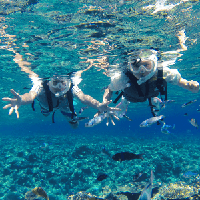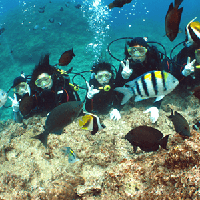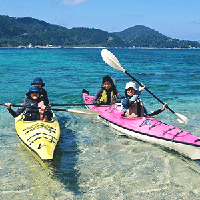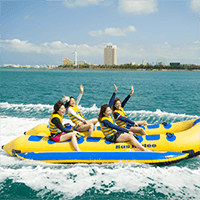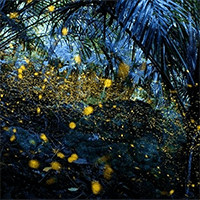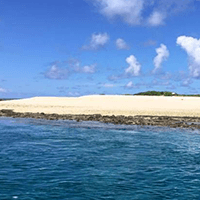【Solo participant】 Kinkakuji/Kitano-tenmangu Area in Guided tour
- Age 1~Age 70
- Over 6 hours on the day
- 08:40 / 09:50
[08:40] ▼Nihonbashi Station Exit 2 (Namba-Shinsaibashi area) [09:50] ▼Kyoto Station Hachijo Exit (in front of 7-Eleven) [10:30] ▼Kinkaku-ji Temple (about 40 minutes) Visiting fees are at the customer's expense. [12:00] ▼Kiyomizu-dera area (individuals visit, stroll freely, lunch on their own / about 3.5 hours) [15:20] ▼Fushimi Inari Taisha Shrine (about 70 minutes) [16:50] ▼After enjoying the day's itinerary, we start to return. [18:10] ▼Shinsaibashi, Dotonbori area (free stroll / about 1 hour) ▼The original name of Kinkaku-ji Temple is Rokuon-ji Temple. It is also called "Kinkaku-ji Temple" because the exterior walls of the Shariden Hall, the central building of the temple, are all decorated with gold leaf. The temple was built in 1397. Originally a villa for Shogun Ashikaga Yoshimitsu (the prototype of Shogun Yoshimitsu in the anime "Kei Ikkyu-san"), it was later converted into the Zen temple "Bosatsurei". If you visit Kinkaku-ji Temple during the autumn foliage season, the golden tower and the red autumn leaves covering the mountain create a spectacular view. (Admission fee: 500 yen for adults, 300 yen for elementary and junior high school students) ▼ Recommended courses around Kiyomizu-dera Temple Recommended course 1: Kiyomizu-dera Temple (admission fee is at your own expense) - Ninenzaka - Ishibekoji - Gion - Hanamikoji - Yasaka Shrine (You can visit several tourist spots according to your preferences and physical condition) Recommended 2: Kimono experience. Interested guests can wear a kimono, stroll through the old streets, visit Kiyomizu-dera Temple, and leave the most beautiful moments. (There are many kimono shops at Kiyomizu-dera and Fushimi Inari Shrine, and you can choose where to return the kimono. We recommend renting at Kiyomizu-dera and returning at Fushimi Inari. You will be responsible for the cost.) ▼ Fushimi Inari Taisha is famous for its thousand torii gates, and many tourists from both Japan and abroad visit it every year. It was ranked number one for three consecutive years as "Japan's most popular tourist spots for foreigners" in a survey conducted by the world's largest travel site. Let's pray for ourselves and our loved ones here. This is a mixed tour, and participants come from all over the world.
- Age 1~Age 70
- Over 6 hours on the day
- 07:30
[07:30-08:30] Pick-up/drop-off/transfer to hotel/private inn Hotels/private inns within the Osaka Loop Line [10:00] ▼Kiyomizu-dera area (individual worship, free stroll, free lunch/approx. 3 hours) [13:30] ▼Fushimi Inari Taisha (individual worship, free stroll/approx. 70 minutes) [15:30] ▼Nara Park (individual worship, free stroll/approx. 1.5 hours) [17:00] ▼After a fun day of sightseeing, start heading back. [18:00] ▼Pick-up/drop-off/transfer to hotel/private inn. Recommended sightseeing courses for hotels and guesthouses within the Osaka Loop Line Course 1: Kiyomizu-dera Temple (Customers are responsible for admission fees.) - Ni, Sannenzaka - Ishibekoji - Gion · Hanamikoji-dori - Yasaka Shrine You can visit your favorite spots according to your physical strength and time ~ Course 2: Kimono experience (Customers who are interested can wear a kimono and enjoy the old townscape and tour Kiyomizu-dera Temple. Let's take pictures of the wonderful moment.) (There are many kimono shops near Kiyomizu-dera Temple and Fushimi Inari Taisha Shrine. We recommend renting a kimono at a shop in Kiyomizu-dera Temple and returning it at a shop in Fushimi Inari Taisha Shrine. Fees are borne by the customer.) Course 3: "Nara Park" where "deer and autumn leaves" are woven together The contrast between the autumn leaves and evergreen trees is vivid Course 4: Todai-ji Temple (Customers are responsible for admission fees.) Todai-ji Temple was built during the Nara period. Nara is popular with tourists and once served as the capital of Japan. It is registered as a UNESCO World Heritage Site as one of the "Historic Monuments of Ancient Nara". Todaiji Temple has eight national treasure buildings, 14 buildings (24 national treasure Buddha statues), and nine other national treasures such as paintings and books. The famous Great Buddha, the Great South Gate, and the Kongorikishi standing statues are all national treasures, as are the Hokke-do Hall, the buildings, and the Buddha statues enshrined within. There are few places in Japan where you can see so many national treasures at once. Admission fees: Todaiji Great Buddha Hall: Adults (junior high school students and above) 600 yen, elementary school students 300 yen; Great Buddha Hall and Todaiji Museum: Adults (junior high school students and above) 1000 yen, elementary school students 400 yenThis is a mixed tour, and participants will come from all over the world.
- Age 1~Age 70
- Over 6 hours on the day
- 08:40 / 09:50
Tour highlights: ・A stroll through the spectacular scenery at the World Heritage site "Kiyomizu-dera Temple" ・A stroll through the ancient capital dressed in an authentic Kyoto kimono (optional) ・The mysterious "Fushimi Inari Taisha" with its thousand torii gates ・Interacting with cute deer in Nara Park ・Visiting the impressive Great Buddha Hall at Todaiji Temple Convenient day trip plan Morning departure - evening return course Good access with departure and arrival in Osaka/Kyoto Early bird discount available! Take this opportunity to enjoy a one-day trip packed with the charms of the ancient capital. ~Schedule for the day~ [08:40] ▼Nihonbashi Station, Exit 2 (Namba-Shinsaibashi area) [09:50] ▼Kyoto Station, Hachijo Exit (in front of 7-Eleven) [10:00] ▼Kiyomizu-dera area (individual visit, free time to stroll, free time for lunch / approx. 3 hours) [13:30] ▼Fushimi Inari Taisha Shrine (individual visit, free time to stroll / approx. 70 minutes) [15:30] ▼Nara Park (individual visit, free time to stroll / approx. 1.5 hours) [17:00] ▼After a fun day of sightseeing, start heading back. [18:00] ▼Shinsaibashi, Dotonbori area (free time/about 1 hour) Recommended sightseeing course Course 1: Kiyomizu-dera Temple (customer pays admission fee) -Ninen-zaka -Ishibekoji -Gion·Hanamikoji-dori -Yasaka Shrine You can visit your favorite spots according to your physical strength and time~Course 2: Kimono experience (Customers who are interested can wear a kimono and enjoy the old townscape and touring Kiyomizu-dera Temple. Let's take pictures of the wonderful moment.) (There are many kimono shops near Kiyomizu-dera Temple and Fushimi Inari Taisha Shrine. We recommend renting a kimono at a shop in Kiyomizu-dera Temple and returning it at a shop in Fushimi Inari Taisha Shrine. Customers are responsible for the fee.) Course 3: "Nara Park" where "deer and autumn leaves" are woven together The contrast between the autumn leaves and evergreen trees is vivid Course 4: Todai-ji Temple (customer pays admission fee) Todai-ji Temple was built in the Nara period. Nara is popular with tourists and once served as the capital of Japan. It is registered as a UNESCO World Heritage Site as one of the "Historic Monuments of Ancient Nara". Todaiji Temple has eight national treasure buildings, 14 buildings with 24 national treasure Buddhas, and nine other national treasures such as paintings and books. The famous Great Buddha, the Great South Gate, the Kongorikishi standing statues, and the Hokke-do Hall, as well as the Buddha statues enshrined therein, are all national treasures. There are few places in Japan where you can see so many national treasures at once. Admission fees: Todaiji Great Buddha Hall: Adults (junior high school students and above) 600 yen, elementary school students 300 yen; Great Buddha Hall and Todaiji Museum: Adults (junior high school students and above) 1000 yen, elementary school students 400 yen This is a mixed tour, and participants will come from all over the world.
最近チェックしたプラン
Please wait a moment
![[Day trip] Kyoto city hotel pick-up and drop-off included. Japanese-style Kyoto sightseeing tour, Kinkaku-ji Temple - Kiyomizu-dera Temple - Fushimi Inari Taisha Shrine. Passing through the 1,000 torii gates.の画像](https://img.activityjapan.com/10/55487/10000005548701_P3BiVCAd_3.jpg?version=1733822342)
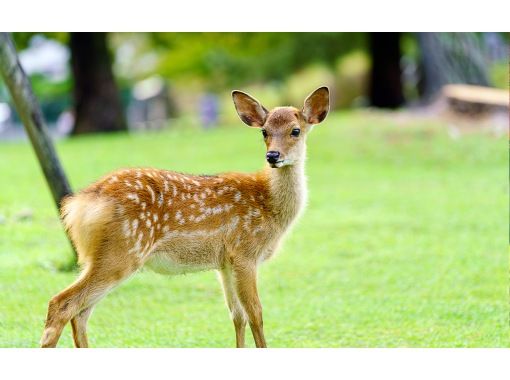
![[SALE] Kyoto and Nara One-Day Tour (Kiyomizu-dera Temple, Kimono Experience, Fushimi Inari Taisha Shrine, Nara Park) (Departing from Osaka/Kyoto)の画像](https://img.activityjapan.com/10/55460/10000005546001_P3BiVCAd_3.jpg?version=1730786226)
